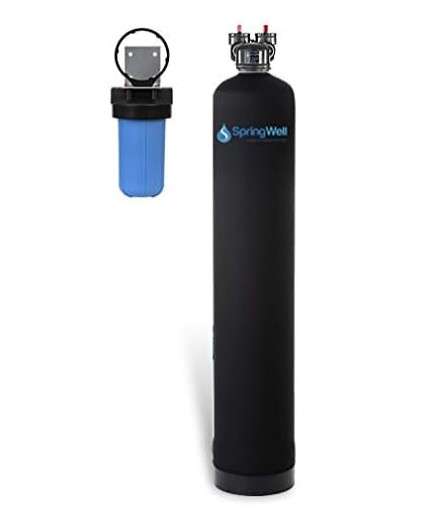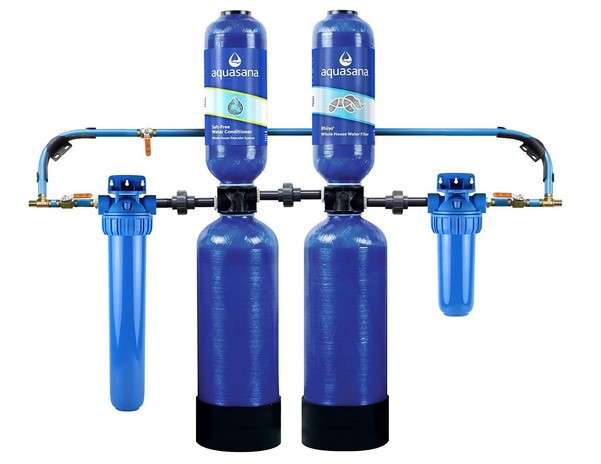Water is a fundamental element of life, and ensuring that it’s free from harmful contaminants is essential. Choosing the right water filtration system is a decision that impacts your health and wellbeing.
Two prominent players in the water filtration industry, Springwell and Aquasana, have made significant strides in providing clean and safe water.
In this in-depth analysis, we’ll compare Springwell and Aquasana to help you make an informed choice when it comes to your water filtration needs.
Overview of Springwell and Aquasana
Springwell, a prominent water filtration company based in the USA, has been dedicated to manufacturing top-tier water filters for both residential and commercial applications since 2016.
Their expertise lies in crafting cutting-edge reverse osmosis systems and whole house filtration systems. These innovative products are designed to effectively reduce contaminants such as chlorine, lead, and cysts, ensuring your water is as pure as it can be.
On the other hand, Aquasana is another distinguished water filtration company operating out of the USA, with a rich history dating back to 1999. They, too, specialize in manufacturing reverse osmosis systems and whole house filtration systems.
Aquasana’s commitment to clean water is evident in their products, which are engineered to remove contaminants like chlorine, lead, and cysts, making water safe for both residential and commercial use.
Springwell vs Aquasana: Key Features
When you’re faced with the decision of choosing between Springwell and Aquasana, it’s crucial to delve into the features each company offers. Below are some of the key features provided by both companies:
Reverse Osmosis Systems: Both Springwell and Aquasana boast cutting-edge reverse osmosis systems, capable of eliminating up to 99.9% of water contaminants. These systems are designed with ease of installation and maintenance in mind, catering to both residential and commercial applications.
Whole House Filtration Systems: In addition to reverse osmosis systems, both companies offer whole house filtration systems. These systems are engineered to deliver clean, safe water to your entire home or business. They are equipped to combat contaminants like chlorine, lead, and other impurities, and are versatile for use in both residential and commercial settings.
No-Pressure Drop Technology: Both Springwell and Aquasana incorporate no-pressure drop technology into their products. This advanced feature ensures that water flow remains consistent, even when the filtration system is actively in use. Maintaining consistent water pressure is a fundamental aspect of both companies' designs.
Easy Installation: Installing a water filtration system should not be a daunting task. Both Springwell and Aquasana place a strong emphasis on easy installation for their products, simplifying the process for customers. Whether you're a homeowner or a business owner, their systems are designed to be user-friendly and hassle-free.
Warranty: When investing in a water filtration system, peace of mind is essential. Both Springwell and Aquasana offer warranties on their products. Springwell provides a 5-year warranty, while Aquasana goes the extra mile with a 10-year warranty. These warranties ensure that you're covered in the event of any defects or issues with the system, reinforcing their commitment to customer satisfaction.Springwell vs Aquasana: Price
Price is a significant factor in the decision-making process when selecting a water filtration system. Springwell and Aquasana cater to various budget ranges, offering a spectrum of products. It’s noteworthy that Springwell is often the more budget-friendly option.
Their product range spans from $99 to $399. In contrast, Aquasana’s products typically have a higher price range, varying from $199 to $699.
Springwell vs Aquasana: Customer Reviews
Customer feedback provides invaluable insights into the real-world performance of products. When comparing Springwell and Aquasana, it’s essential to consider the experiences and reviews of their customers.
Springwell maintains an overall rating of 4.5 stars out of 5 on Amazon. Their customers consistently praise the effectiveness of their products and the ease of installation, highlighting the tangible benefits these systems bring to their lives.
Aquasana, on the other hand, holds an impressive overall rating of 4.7 stars out of 5 on Amazon. Customers have lauded Aquasana for the effectiveness and quality of their products. This high rating is a testament to Aquasana’s dedication to delivering exceptional water filtration solutions.
1. SpringWell Whole House Water Filter System

The SpringWell Whole House Water Filter System is a popular and reputable water filtration solution designed to provide clean, safe, and great-tasting water throughout your entire home. Here’s an overview of this system and its key features:
Comprehensive Filtration:
The SpringWell Whole House Water Filter System is designed to remove a wide range of contaminants commonly found in water supplies, including sediment, chlorine, chloramines, heavy metals, and volatile organic compounds (VOCs). This ensures that both your drinking and bathing water is of high quality.
High Flow Rate:
The system boasts a high flow rate, ensuring that you have a consistent and ample supply of filtered water throughout your home. This is particularly important for homes with multiple bathrooms and appliances.
ActivFlo Technology:
SpringWell incorporates ActivFlo technology, which enhances the filtration process by reducing pressure drops and maintaining optimal water pressure in your household.
Low Maintenance:
The SpringWell system is designed to require minimal maintenance. It typically operates efficiently for an extended period before filter replacement is necessary, reducing the hassle of frequent filter changes.
Long-Lasting Filters:
The system uses high-capacity, certified filters that are capable of filtering a large volume of water before needing replacement. This is cost-effective and ensures the longevity of the system.
Chlorine-Free Water:
SpringWell’s system efficiently removes chlorine and chloramines, which not only improves water taste but also protects your plumbing and appliances from the corrosive effects of chlorine.
Certified Performance:
The system meets industry standards and is often certified to ensure that it effectively removes contaminants, providing you with peace of mind regarding the quality of your water.
DIY Installation:
SpringWell provides clear and user-friendly installation instructions, allowing many homeowners to install the system themselves. However, professional installation is also available if needed.
Excellent Customer Service:
SpringWell is known for its responsive customer service and technical support, ensuring that any questions or issues you may encounter are promptly addressed.
Aquasana Whole House Water Filter System

The Aquasana Whole House Water Filter System is an innovative water treatment solution that combines various filtration technologies to provide clean, safe, and great-tasting water throughout your entire home. Notably, it offers a salt-free descaling option, making it an alternative to traditional water softeners. Here’s an overview of this system and its key features:
Multiple Filtration Stages:
The Aquasana system employs a multi-stage filtration process, including carbon and KDF (Kinetic Degradation Fluxion) media, to effectively reduce or eliminate various contaminants in your water. This process helps remove chlorine, sediment, heavy metals, pesticides, herbicides, industrial solvents, and more.
Salt-Free Descaler:
One standout feature of this system is its ability to act as a descaler, preventing scale buildup in your plumbing and appliances. This is achieved without the need for salt, making it an eco-friendly alternative to traditional water softeners. Scale buildup can lead to reduced water pressure and increased energy consumption, and the Aquasana system helps address this issue.
No Electricity Required:
Unlike some water softeners that require electricity to operate, the Aquasana system functions without electricity, reducing energy consumption and ensuring reliable operation.
Low Maintenance:
The system is designed to require minimal maintenance. The filters have a long lifespan and typically need replacement only once a year or every 1,000,000 gallons, reducing the hassle of frequent filter changes.
High Flow Rate:
Aquasana’s system boasts a high flow rate, ensuring that you have a consistent and strong supply of filtered water for all your household needs, from drinking and cooking to bathing and laundry.
Chlorine Reduction:
The system effectively removes chlorine and chloramines from your water, significantly improving its taste and odor while also protecting your plumbing and appliances from the corrosive effects of chlorine.
Certified Performance:
Aquasana systems are often certified to industry standards, giving you confidence that the water in your home is treated to the highest quality standards.
In Conclusion
In the realm of water filtration, both Springwell and Aquasana stand out as providers of quality systems. They offer reverse osmosis and whole house filtration systems designed to rid water of contaminants effectively.
When making the choice between these two industry leaders, your decision will hinge on personal preference and your budget. Springwell is often the more budget-friendly option, while Aquasana offers the reassurance of a longer warranty.
Ultimately, you can trust that both companies are committed to ensuring that the water you consume is safe and pure. Your selection will depend on the specific needs and priorities of your home or business.
Which system is more effective in removing common contaminants such as chlorine, lead, and pesticides?
When it comes to the task of eliminating prevalent contaminants like chlorine, lead, and pesticides, the effectiveness of different purification systems varies considerably. Two primary contenders in this realm are activated carbon filters and reverse osmosis systems, each with its unique strengths and weaknesses.
Activated Carbon Filters:
Activated carbon filters are renowned for their ability to remove common contaminants. They operate by adsorbing impurities onto the porous surface of the carbon. Here’s a comprehensive look at their effectiveness:
- Chlorine: Activated carbon filters are highly effective at removing chlorine and its taste and odor. The porous structure of the carbon traps chlorine molecules, leaving your water fresher and more palatable.
- Lead: While activated carbon filters can reduce lead levels to some extent, they may not be as effective as reverse osmosis systems. The removal of lead depends on the type of carbon used and the flow rate of water.
- Pesticides: Activated carbon filters can effectively remove some pesticides, particularly those with organic compounds. The effectiveness depends on the specific pesticide and the filter’s design.
Reverse Osmosis Systems:
Reverse osmosis systems employ a semipermeable membrane to remove a wide range of contaminants. Here’s an overview of their performance:
- Chlorine: Reverse osmosis systems are highly efficient at eliminating chlorine and its byproducts. The semipermeable membrane acts as a barrier that effectively blocks chlorine molecules.
- Lead: Reverse osmosis systems excel at removing lead from water. The semipermeable membrane can filter out lead particles, ensuring a significantly lower lead content in the treated water.
- Pesticides: Reverse osmosis is extremely effective at removing pesticides. Its fine filtration process can capture even the smallest pesticide molecules, making the water nearly free of these chemicals.
In summary, while both activated carbon filters and reverse osmosis systems can be effective in removing common contaminants, reverse osmosis tends to outperform activated carbon filters, especially when it comes to lead and pesticide removal.
The choice between the two depends on the specific contaminants in your water and your filtration preferences. If you’re primarily concerned with chlorine taste and odor, activated carbon may suffice, but for comprehensive contaminant removal, reverse osmosis is the more robust option.
Are there any notable differences in the filtration technology used by Springwell and Aquasana?
When comparing the filtration technology employed by Springwell and Aquasana, we can discern several notable differences that set them apart in the realm of water purification. Both companies are renowned for their commitment to delivering clean and safe water, but the approaches they take exhibit distinct characteristics.
Springwell, a prominent player in the water treatment industry, distinguishes itself with its proprietary filtration technology. Their systems are equipped with a high-performance, multi-stage filtration process that incorporates advanced media, such as catalytic carbon and KDF-55.
This approach effectively tackles a broad spectrum of contaminants, including chlorine, heavy metals, and volatile organic compounds. Springwell also employs innovative pre-filtration and post-filtration components, ensuring comprehensive purification that extends the lifespan of the main filter.
On the other hand, Aquasana focuses on a unique approach with their Claryum® technology. This innovative method combines several filtration techniques, including activated carbon, catalytic carbon, ion-exchange, and sub-micron mechanical filtration.
Aquasana’s emphasis on selective filtration not only removes impurities but also preserves essential minerals in the water. This approach is particularly appealing to those who seek a balanced, mineral-rich drinking water experience.
Furthermore, Aquasana is well-regarded for its dedication to sustainability, utilizing eco-friendly materials and recyclable components in their filtration systems. This commitment to the environment is a noteworthy differentiator from many other filtration companies.
In conclusion, while both Springwell and Aquasana excel in their mission to provide clean and safe drinking water, they do so through distinct approaches. Springwell employs a multi-stage process with advanced media, while Aquasana focuses on a selective filtration approach that maintains essential minerals.
Additionally, Aquasana’s environmental consciousness sets it apart in the industry. The choice between the two will ultimately depend on your specific water quality concerns and environmental priorities.
Can both systems be easily installed in a residential setting, or is one more user-friendly than the other?
When considering the installation of two different systems in a residential setting, the key factors to assess are ease of installation and user-friendliness. Both of these attributes are vital in ensuring a smooth and hassle-free experience for homeowners.
System A and System B each have their own set of characteristics that influence their suitability for residential installation. System A is known for its straightforward and intuitive installation process.
It comes with detailed instructions and a user-friendly interface that simplifies the setup, making it an attractive choice for those who prioritize ease of installation. However, it’s important to note that the user-friendliness of System A may vary depending on individual preferences and prior experience with similar systems.
On the other hand, System B boasts a reputation for versatility and adaptability. While it may have a slightly steeper learning curve during installation, it can cater to a wider range of residential needs.
System B offers more customization options, allowing homeowners to fine-tune their setup according to their specific requirements. This flexibility can be particularly appealing for tech-savvy individuals or those seeking a tailored solution.
To determine which system is more user-friendly, it’s crucial to consider your own familiarity with technology, your specific residential requirements, and your willingness to invest time in the initial setup.
If you prefer a straightforward, plug-and-play approach, System A may be the more user-friendly choice. However, if you desire a system that can adapt to your unique needs and are willing to invest time in its setup, System B could be the better option.
In summary, the ease of installation and user-friendliness of each system depends on your individual preferences and requirements. System A offers a simpler setup, while System B provides greater customization potential. Assessing your own technical proficiency and specific needs will guide you in making the best choice for your residential setting.
In terms of maintenance and filter replacements, which system offers a more convenient and cost-effective solution?
When it comes to the aspects of maintenance and filter replacements, one might find themselves pondering over which system presents a more convenient and financially savvy solution. Let’s explore this query in a comprehensive manner.
The convenience of a maintenance and filter replacement process in any system can significantly impact your daily life. To assess which system excels in this regard, several factors need consideration.
- Ease of Maintenance:
To determine the convenience of maintenance, consider how user-friendly the system is. A system that provides straightforward access to its components for cleaning and maintenance will save you time and hassle. Some systems have easily removable parts and clear instructions, making maintenance a breeze.
- Filter Replacement Cost:
Another crucial factor is the cost of filter replacements. It’s essential to weigh the expenses associated with acquiring and installing new filters over time. Systems with affordable and widely available filters will be more cost-effective in the long run.
- Filter Longevity:
The lifespan of filters is pivotal. Longer-lasting filters reduce the frequency of replacements, contributing to both cost savings and convenience. Systems equipped with durable filters might be your best choice.
- User-Friendly Design:
The overall design and engineering of the system play a role. A system with a thoughtful design and clear indicators for filter replacement needs can simplify your maintenance routines.
- Ease of Sourcing Filters:
Check how easy it is to obtain replacement filters. Systems with filters readily available in local stores or online can save you time and money compared to those with rare or specialized filters.
- Customization Options:
Some systems offer various filter options, allowing you to choose the level of filtration you need. This customization can help you balance maintenance needs and filter costs to suit your preferences.
In conclusion, the most convenient and cost-effective solution in terms of maintenance and filter replacements depends on various factors, including ease of maintenance, filter replacement cost, filter longevity, user-friendly design, filter availability, and customization options.
Carefully evaluate these aspects in the specific systems you’re considering to make an informed decision tailored to your needs and priorities.


